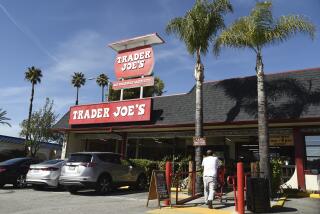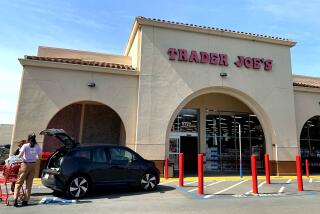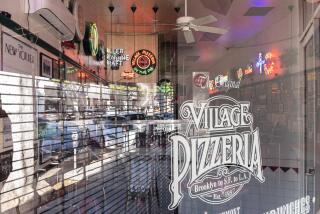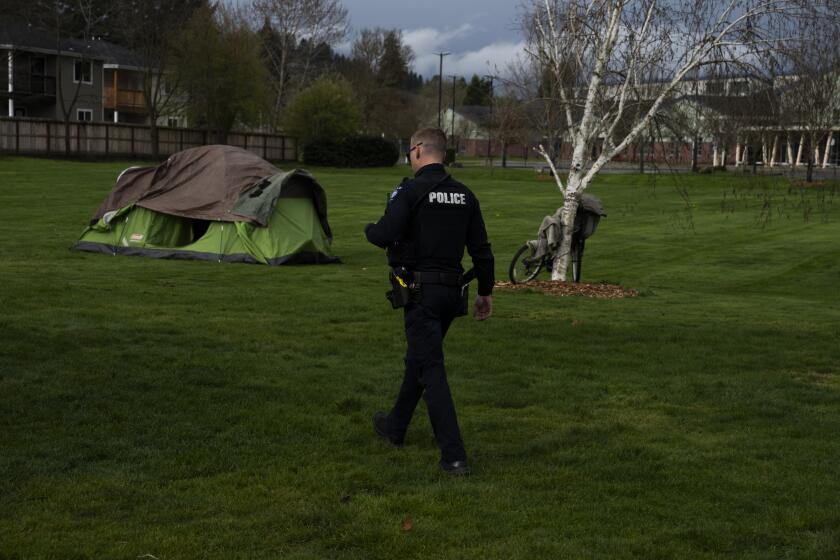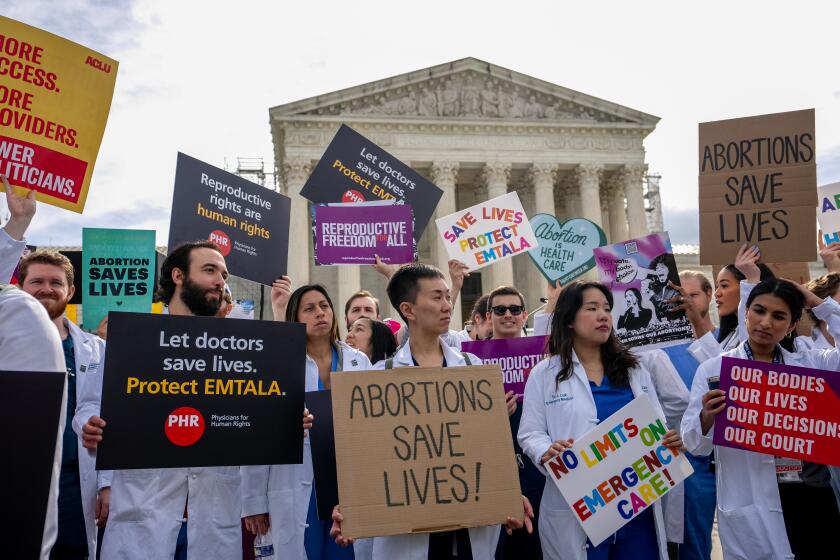Joe’s Joe: Joe Coulombe
I was traveling to Washington early in the George W. Bush administration and asked a friend who was working in the White House whether I could bring her something from L.A. Was there anything she really, really missed? Yes, she said: Trader Joe’s Mt. Baldy trail mix.
Everybody’s got a Trader Joe’s story, and the original one belongs to the original Joe, Joe Coulombe, the founder, a San Diego native and Stanford MBA. He parted company with Trader Joe’s more than 20 years ago, but he has hardly been idle -- sitting on boards, advising companies, speaking at South Pasadena’s Rotary Club, wine touring in France and painting pictures of relatives and friends (he’s holding a self-portrait with grandchild.)
His most famous offspring, Trader Joe’s, is privately owned by a trust founded by a German grocery chain family. It now operates in more than two dozen states, and even in the nation’s capital. But it is still an L.A. institution at heart -- like its founder.
Trader Joe’s has become something of a lifestyle feature here, like the weather. It’s hard to imagine Southern California without it. How did it start, and why?
I had opened a chain called Pronto markets. I got financing from Adohr Milk Farms, but in late 1965, Adohr was bought by 7-Eleven, which meant the 800-pound gorilla of convenience stores was not only coming to town but now owned my source of capital. So I had to do something different. Scientific American had a story that of all people qualified to go to college, 60% were going. I felt this newly educated -- not smarter but better-educated -- class of people would want something different, and that was the genesis of Trader Joe’s.
All Trader Joe’s were located near centers of learning. Pasadena, where I opened the first one, was because Pasadena is the epitome of a well-educated town. I reframed this: Trader Joe’s is for overeducated and underpaid people, for all the classical musicians, museum curators, journalists -- that’s why we’ve always had good press, frankly!
I can’t think of Trader Joe’s and 7-Eleven as competitors. It’s like Twinkies versus tofu.
That was true of Pronto Markets too. Pronto was the first drugstore to sell health and beauty aids, to sell paperback books, to promote photo finishing. It was a big deal. We tried a lot of things.
And you sold ammunition for a while!
That’s right, until Robert Kennedy got shot and all kinds of new rules came in.
You opened the first Trader Joe’s in 1967. What made it different?
The fundamental difference between Trader Joe’s and all other retailers is the income level of employees. I said the average full-time employee will make median family income for California. In those days that was about $7,000. Median family income soared, but we stayed with it, and today [Trader Joe’s stores pay] whatever it is, $58,000, $59,000. That will vary state by state. And the benefits are rich -- medical plans, extended in recent years to part-time employees.
What I keep telling people [is] forget about the merchandise; it’s the quality of the people in the stores. [At Trader Joe’s the] tenure is typically 35 years. I call them the roach motels: They check in and they don’t check out. Some of the people I hired in the 1960s [are] finally retiring. We also made a real effort to hire women managers. So it’s the quality of the people and new ideas. This was not a one-man show.
I will say this: The Pill disrupted my supply of manpower. Once [it] kicked in, there weren’t so many forced marriages where the guy had to go to work!
You used scarcity as a marketing tool; some item may be there for a while, but you can’t count on it being there forever, like items in grocery stores.
I learned that lesson with vintage wines. There’s only so much 1966 Lafite Rothschild. So we deliberately pursued a policy of discontinuity, as opposed to, say, Coca-Cola, which is in infinite supply. For example, we had the only vintage-dated, field-specific canned corn in existence, and it was the best damned canned corn there was. But there was only so much produced every year, and when you’re out, you’re out.
Trader Joe’s expanded into Northern California before you left the company in 1989. When it went out of state, were you concerned about its maintaining quality?
A lot of things are made possible now by the new electronics, the ability to communicate with distribution centers and vendors. Circa 1982, thanks to my son, who is a Macintosh freak, we had an Apple II to communicate with 13 small bakers. It was a primitive version of what goes on today. Basically all the Western United States is served out of Chino; back East everything is served out of a place near Boston. The more distribution centers you have, the more problems you have, exponentially. The East Coast doesn’t have the same products as the West Coast.
There’s a Facebook battle in Alabama to get a Trader Joe’s. It’s become like landing an NFL franchise.
I had that in California. Claremont was especially noisy, but unless you have enough well-educated people, Trader Joe’s will not work. Claremont had well-educated people, but not enough. They have one [there] now.
Why do you think people still identify you with the chain, rather than the German owners?
I did over 3,000 one-minute broadcasts on KFAC, the classical music station; each broadcast closed, “This is Joe Coulombe of Trader Joe’s.” That was one of the ways I built the profile. Also, because I didn’t know anything about food and wine, I used [the broadcasts] as a means of forcing myself to learn. I was 37 years old when we started Trader Joe’s. I’d been in the grocery business 10 years; grocers don’t know anything about what they sell. I was a rum drinker!
But you didn’t do the hard sell?
No, no, it was “If you don’t buy this, it’s all right, we’ve signed 30-year leases.” On the other hand, if you don’t buy it, it may be gone pretty soon.
This was one of my most important principles: Never have a mandatory sell. This rule gets violated all the time; it just drives me nuts: “Buy now!” You never give an order to a customer.
When I was selling Kirby vacuum cleaners at Stanford door to door, that’s where I learned negative selling. You go in and say, “Well, I really don’t think you can afford this.” Sometimes they did buy; you don’t make a sale on every call.
Why was a German company interested in buying Trader Joe’s?
In those days, the average store size was about the same as their Aldi [markets]. I dissuaded them from using Trader Joe’s as a vehicle to launch Aldi. Pretty soon they came to realize that Trader Joe’s was a unique vehicle. They’ve been wonderful owners. We had in essence a one-page agreement. O’Melveny & Myers refused to write it! So my lawyer did. You can’t have a one-page agreement today.
If I were to go into your kitchen now, would I find a lot of Trader Joe’s stuff?
I buy Trader Joe’s mayonnaise. I do a lot of shopping at Costco, and at Cost Plus [whose board he chairs].
Was there a real Charles T. Shaw, of two-buck Chuck fame?
Oh yes. He was a banker who went to work in Paris; fell in love with Beaujolais. I met him once, in the 1980s. He had a winery in the Napa Valley. Went bankrupt. And Fred Franzia, the largest owner of vineyards in the United States, he bought the name, he bought the brand.
I tell people, on every case there’s not only a date, there’s an hour code. Write that down and if you like that bottle, go back and try to find the same date and hour. [The wine] will vary tremendously because of the volume -- 6 million cases or whatever it is a year. It is discontinuous; you cannot count that next month your Charles T. Shaw Cabernet Sauvignon will taste same as the last one.
Trader Joe’s had nectarines from Chile, noodles from Thailand. Now we’re concerned with carbon footprints and locally grown foods.
An article in the New York Times said that in the recession, the green pitch isn’t working anymore and organic sales have fallen sharply. I’ve always felt the whole organic idea was a fraud. There are some very legalistic definitions [to organic]. It’s one thing to have organics, and it’s another thing to avoid certain additives like extra sugar and flavor enhancers and artificial colors. That’s what we were doing.
And the private label?
We didn’t inaugurate it; we changed its character. There are a lot of products which have no branding. We put our name on it. We were the first essentially to sell frozen fish. We went down to San Pedro and we’d buy it and freeze it and it was a huge success. If you want really fresh seafood, buy it frozen -- if it has been frozen the minute it hits the deck.
People talk about L.A.’s restaurants changing the city’s tastes, but few people go to those restaurants and many go to Trader Joe’s and see an Indian dish or a Peruvian dish and think, well, for four bucks, I’ll try that.
Some of changing [people’s taste] was simply by breaking the price on things that had been too expensive. Wild rice -- we found that farmers around Sacramento were starting to grow wild rice, and we broke the price on wild rice. And supermarkets didn’t pay any attention to capers -- we broke the price on capers. Supermarkets don’t have the imagination, and that’s OK, because they’re trying to be all things to all people.
In the late 1970s, did you lobby to break the fair-trade rules that set minimum prices on many items?
I didn’t lobby to repeal it. In fact, people thought we’d go bankrupt when fair trade was repealed. I didn’t, because I had paid off all debt in 1975. Trader Joe’s never had one penny of debt [after that] and that was one of the reasons we were able to make so many deals -- we could wire cash. When fair trade went out, man, we took that and we ran with it, and within 90 days we were making more money than ever before.
How did Fearless Flyer get started?
It’s based on Consumer Reports physically, page size, column width, but I jazzed it up with cartoons. And its writing: I [emulated] New York magazine. Writing that copy was another form of getting educated.
Because we didn’t have any money, I only used artwork [from] prior to 1906 because there was no copyright until 1906. So I collected adventure books from the 1860s and Punch Magazine and Harper’s for the cartoons. In those days you didn’t have Photoshop. I [did it] with scissors and Scotch tape.
The original South Seas theme has been downplayed.
I read that the 747 would radically reduce the cost of travel, and I came up with the term “Trader” to evoke the South Seas. The first stores were loaded with marine artifacts. We’d go down to the docks in San Pedro, we’d buy flags, chains, all that stuff. I [put] walk-in boxes in the shape of ships with cannon in the middle of the stores. That was a terrible idea.
Trader Joe’s has a no-questions-asked return policy. I just returned a guacamole-hummus mix. It was disgusting.
My daughters love hummus. My wife likes it. I don’t like it. It’s a downer flavor.
This interview was edited and excerpted from a longer taped transcript. Interview archive: latimes.com/pattasks.
More to Read
A cure for the common opinion
Get thought-provoking perspectives with our weekly newsletter.
You may occasionally receive promotional content from the Los Angeles Times.
